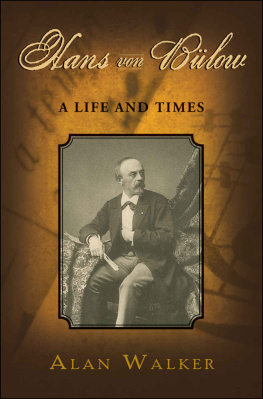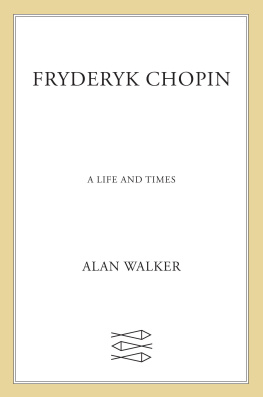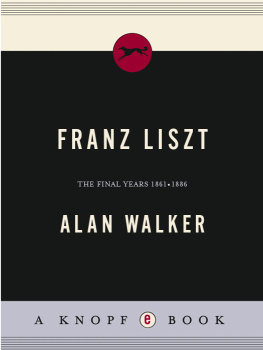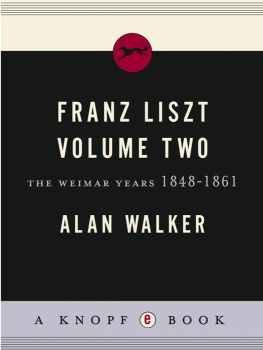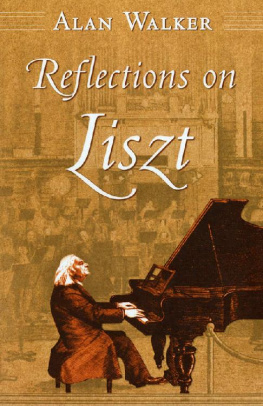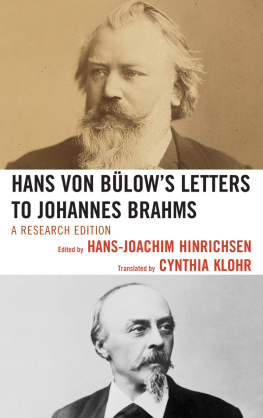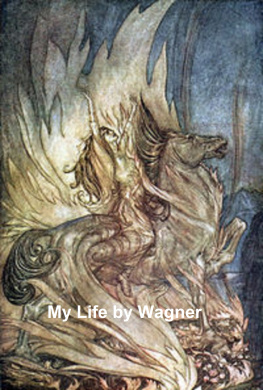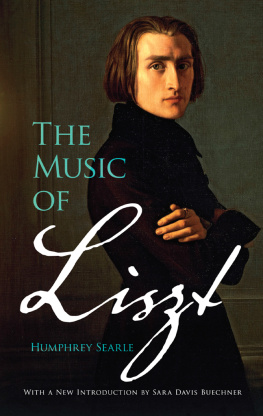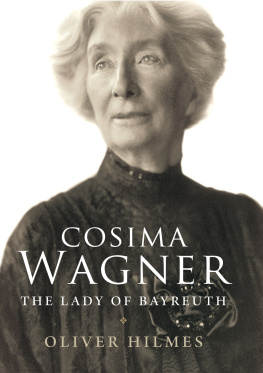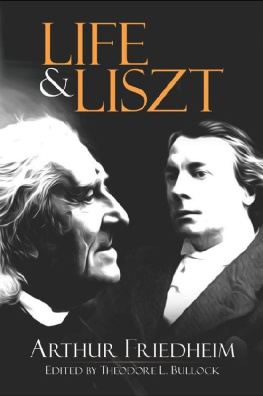Hans von Blow
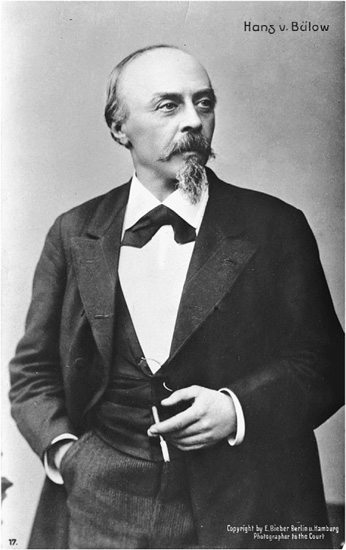
Hans von Blow in 1886. A photograph by E. Bieber.
Hans von Blow
A LIFE AND TIMES
ALAN WALKER


Oxford University Press, Inc., publishes works that further
Oxford Universitys objective of excellence
in research, scholarship, and education.
Oxford New York
Auckland Cape Town Dar es Salaam Hong Kong Karachi
Kuala Lumpur Madrid Melbourne Mexico City Nairobi
New Delhi Shanghai Taipei Toronto
With offices in
Argentina Austria Brazil Chile Czech Republic France Greece
Guatemala Hungary Italy Japan Poland Portugal Singapore
South Korea Switzerland Thailand Turkey Ukraine Vietnam
Copyright 2010 by Alan Walker
Published by Oxford University Press, Inc.
198 Madison Avenue, New York, New York 10016
www.oup.com
Oxford is a registered trademark of Oxford University Press
All rights reserved. No part of this publication may be reproduced,
stored in a retrieval system, or transmitted, in any form or by any means,
electronic, mechanical, photocopying, recording, or otherwise,
without the prior permission of Oxford University Press.
Library of Congress Cataloging-in-Publication Data
Walker, Alan, 1930
Hans von Blow: a life and times / Alan Walker.
p. cm.
Includes bibliographical references and index.
ISBN 978-0-19-536868-0
1. Blow, Hans von, 18301894. 2. Conductors (Music)GermanyBiography. I. Title.
ML422.B9W36 2009
780.92dc22[B] 2008039701
9 8 7 6 5 4 3 2 1
Printed in the United States of America
on acid-free paper
To the memory of
Marie von Blow
Keeper of the flame
Acknowledgements
Hans von Blows vast legacy, scattered across a wide variety of locations, reflects a life of ceaseless travel. He is known to have given more than 3,000 concerts during his career as a pianist and conductor. His long and arduous tours took him through a dozen or more countries, and left a complex trail of paper in their wakeprogrammes, newspaper reviews, photographs, reminiscences, diary entries, and correspondence. Much of this material is esoteric and remains unpublished. But it is not possible to write a reliable account of Blows life without taking it into account. It is my pleasant duty to thank all those colleagues who helped me along the way.
I have elsewhere spoken of the geography of biography, of the absolute necessity for biographers to visit the places about which they write, without which it is virtually impossible for the spirit of times past to penetrate their work. A single walk across Dresdens venerable Augustus Bridge, which spans the river Elbe, did more to stimulate my recalcitrant pen into capturing the details of Blows childhood than did the perusal of a dozen articles in remote libraries. Equally memorable were my visits to Blows impressive grave in Hamburgs Ohlsdorf Cemetery, and the great St. Michaelis Church where the funeral ceremony itself was held. Several accounts of Blows obsequies have come down to us, of course, but for me they refused to leap from the page until I had experienced these geographical locations for myself.
As for such cities as Berlin and Meiningen, with whose orchestras Blow achieved his greatest triumphs, they are an indispensable part of the biographers itineraryeven though a number of places associated with his career were destroyed during World War II. My guide on all these visits to Germany was Dr. Horst Frster, who lavished the same attention on my work as if it had been his own, and he opened doors for me, particularly in Berlin and Hamburg, which might otherwise have remained closed. I remain grateful to him.
By far the largest Blow archive is held in the Deutsche Staatsbibliothek in Berlin. It was deposited there by Blows second wife, the actress Marie Schanzer, in several installments between the two world wars. On various visits to the Staatsbibliothek I was helped by the music archivist Frau Ute Nawroth, herself a Blow specialist, and by her colleagues. Documents that might have taken days for me to uncover in this largely uncatalogued collection were made readily available for my inspection, and simplified my work.
My visits to the Meininger Museen and the Meininger Staatsarchiv were likewise made easier for me by the support I received from Frau Maren Goltz, the chief music archivist. Blow spent five years of his life in Meiningen, directing the Court Orchestra and bringing it to the forefront of Europes musical life. The archive, which is housed in the ducal castle, contains a rich supply of memorabilia, to which I was given free access.
Many other organizations supported me in my work, of course, together with individual members of their respective staffs, and it is a pleasure to acknowledge them here. Among the most important were: Fran Barulich and the New York Public Library for the Performing Arts; Jane Gottlieb and the Juilliard School of Music Library; Catherine C. Rivers and the Music Division of the Library of Congress; Donald Manildi and the International Piano Archives, University of Maryland; Mria Eckhardt and the Liszt Museum and Research Centre, Budapest; Robert Parker and the Music and Rare Books Division of the British Library; Jonathan Summers and the British Library Sound Archives; Paul Collen and the Centre for Performance History at the Royal College of Music, London; Sally-Anne Coupar and The Hunterian Museum, University of Glasgow; and Rosemary Johnson and the Royal Philharmonic Society, London. Among other individuals who helped in important ways were Professor William Renwick, who designed the music examples; Professor Hans Schulte and Professor Gabriele Erasmi who served as linguistic consultants; and Laura Siegel, Dominique Caplier, Nadejda Vlaeva and Peter Frster, who dealt with a medley of musicological inquiries arising from my biographical narrative. I am likewise grateful to Professor Alan McComas, in the Department of Neurology at McMaster University, Canada, for throwing light on many of the baffling symptoms associated with Blows terminal illness and death, and encouraging me to explain them in terms that a layman could understand. There could be few better guides through the maze that constitutes Blows family tree than Anna Gravina, one of his direct descendants, and I greatly appreciate her assistance in helping me to fill in some gaps in the genealogical table on pp. xxvixxvii. To Peggy Find-lay, Helen Creedon, and the staff of the Inter-Library Loans Services at McMaster University, I extend my special thanks. The care they expended on my numerous requests for assistance, over a very long period of time, was exemplary.
My colleague William Wright was generous to a fault in his support of my project across the years. He not only helped me put the finishing touches to my account of Blows visits to Scotland (the details of which still remain a closed book to many scholars), but also drew my attention to a rich variety of unpublished sources, some of which I was able to integrate into my text. He also read through the entire book in typescript, a heroic task, and made a number of practical suggestions along the way. The help I received from Lisa Yui must also be acknowledged. She spent many a difficult hour in the mustiest corners of New Yorks research libraries, in pursuit of materials having to do with Blows American tours. More than once these scholars struck gold, and the fruits of their work have left their impression on my narrative.
Next page
